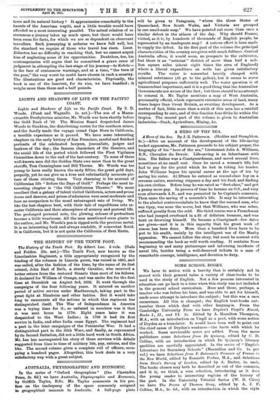SOME SCHOOL BOOKS.
We have to notice with a brevity that is certainly not in accord with their general value a variety of class-books to be used in the study of English. Not a few persons interested in education can go back to a time when this study was not included in the general school curriculum. Here and there, perhaps, a, teacher who was before his time, and was able to act for himself, made some attempt to introduce the subject ; but this was a rare occurrence. All this is changed ; the English text-books out- number those which deal with other languages. From the Cambridge University Press we have Dryden's Virgil's iEneid, Books I., II., and VI. ls. Edited by A. Hamilton Thompson, M.A., with an introduction on Virgil as a poet, with some notice of Dryden as a translator. It would have been well to point out the chief cause of Dryden's weakness—the haste with which he worked. Some serviceable notes are added. From the same publishers come Selections from De Quincey, edited by C. D. Collins, with an introduction in which De Quincey's literary qualities are carefully appreciated. In the series of "English Literature for Secondary Schools " (Macmillan and Co. Is. per vol.) we have Selections from P. Bateman's Pioneers of France in the New World, edited by Kenneth Forbes, M.A., and Selections from Stow's Survey of London, edited by A. Barter, 1s. each. The books chosen may both be described as out of the common, and it is, we think, a wise selection, introducing as it does the young reader to interesting regions of the history of the past. In the University Tutorial Series (W. B. Clive) we have The Poems of Thomas Gray, edited by A. J. F. Collins, M.A., 2s. 6d., with an introduction in which the style metrical qualities, etc., of the poet are fully treated; and Chaucer's Pardoner's Tale, edited by C. M. Drennan, M.A., and A. J. Wyatt, M.A., 2s. 6d. Picture Composition, Books I., IL, by Lewis Marsh (Blackie and Son. 6d. per book), is an ingenious attempt to utilise pictures as a help in the teaching of languages. Book I. begins with a picture of a hen and chickens on one page, and facing it a number of questions and suggestions as to words and phrases to be used in describing their doings. In the same publishers' " Story Book Readers " we have Victoria the Good and Edward the Peacemaker, 4d. The same publishers also send us in their " Plain Text Poets" Tennyson's Earlier Poems, 6d., also Poetica: a Book of English Verse, chosen and arranged by John Bridges, M.A., "intended to serve as a short anthology for boys and girls for the three years ending at 15 or 16." The absence of several well- known pieces is accounted for by the statement that this volume is supplementary to the ordinary text-books. We have also to mention Black's Literary Readers, Book V., written and edited by John Finnemore (A. and C. Black. 1s. 6d.). Here we have a mixture of the old and new. The editor lays Dickens and Scott and others under contribution, and himself contributes chapters on Captain Cook and the growth of Australia, South Africa, etc. We [have to notice in Messrs. Blackie and, Son's series of "Lands and their Stories" Europe and its Peoples, by H. W. Palmer, with appendices by David New, B.A., ls. 8d., and England and the English, by A. J. Berry, M.A., with appendices as above, ls. 3d.--A New Star Atlas, by Arthur P. Norton, B.A. (Gall and Inglis, 5s. net), is meant "for students and amateurs " (having the use of a telescope, it will be understood). It is de- scribed as " covering the whole Star Sphere, and showing over 7,000; Stars, Nebulas and Clusters ; with short descriptive lists of Objects suitable for Small Telescopes ; Notes on Planets; Star Nomenclature, &c."



























































 Previous page
Previous page